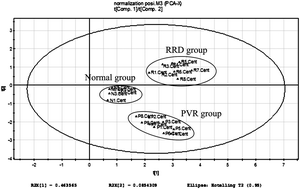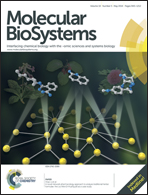Investigating the pathological processes of rhegmatogenous retinal detachment and proliferative vitreoretinopathy with metabolomics analysis
Abstract
Proliferative vitreoretinopathy (PVR) develops as a complication of rhegmatogenous retinal detachment (RRD). The unclear pathological pathways of PVR and RRD have been the biggest obstacle for successful retinal reattachment. In this study, a metabolomics approach using reversed-phase liquid chromatography-quadrupole time-of-flight mass spectrometry (LC-Q-TOF-MS) was developed to obtain a systematic view of the pathological processes of RRD and PVR. Through a partial least squares discriminant analysis (PLS-DA) method, 31 biomarkers were identified in the vitreous samples of RRD and PVR patients. Sixteen pathways participated in the development of RRD and PVR. Through analyzing the biological effects of those identified biomarkers, inflammation, proliferation and energy consumption were the three major disturbed biological processes involved in the RRD and PVR development. Inflammation happened in the pathological processes of RRD, and proliferation mainly happened during PVR formation. The established network of biomarkers indicated that the histidine metabolism and citrate cycle were seriously disturbed during the RRD and PVR development. The metabolomics study supplied a systematic view of the development and progression of RRD and PVR on a metabolite level.


 Please wait while we load your content...
Please wait while we load your content...